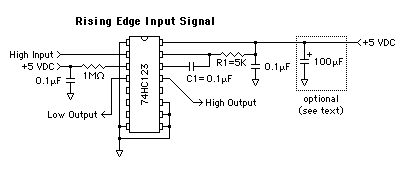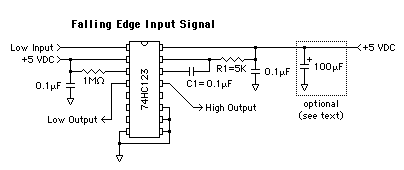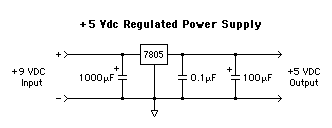Frequently Asked Questions
DIY Retriggerable Status Indicator Circuit
It is sometimes necessary to monitor a device that generates a relatively short pulse to indicate a change of status. If the duration of the input signal is too short, the RFC-1/B may not have time to capture the pulse and respond appropriately.
Note that we are discussing a relatively small number of devices because most equipment indicates status with a steady-state signal, not a pulse.
The RFC-1/B alarm system scans one alarm channel every ten seconds. Depending on the number of alarms in use, it may take several seconds for the alarm system to scan the channel and the input pulse may have expired.
An effective solution is to extend the duration of the pulse to give the RFC-1/B time to sense the signal. The circuits below do just that. One detects a pulse on the rising edge and the other detects a pulse on the falling edge.
These circuits use a readily available IC, the 74HC123A, to sense the input pulse and generate an output pulse that can last several seconds. If a second input pulse arrives before the first output pulse has completed, the output signal timer restarts.
Do not apply an input signal greater than 5 VDC to the 74HC123A or the IC will be damaged. Use a pot or an L-pad to reduce the input signal voltage.
The 74HC123 is a dual timer IC. Only one timer is used for this pulse extender so two circuits can be built with one IC. The schematics show wiring for only one timer to simplify the drawing.
Inverter
Both circuits offer the option of either a high (+5 VDC) or low (0 VDC) output so these circuits can act as an inverter if necessary. Both outputs are shown in the schematics.
Timing Options
The duration of the output signal depends on the choice of resistor R1 and capacitor C1. The values in the schematic produce an output pulse of about 30 seconds.
- Use C1=0.1µF and R1=5K for an output pulse of about 30 seconds
- Use C1=0.1µF and R1=10K for an output pulse of about 1 minute
- Use C1=1.0µF and R1=10K for an output pulse of about 10 minutes
Power Supply
Any regulated 5 VDC power supply should work. The parts list includes an inexpensive switching supply that will work. The optional 100µF capacitor should be added if this switcher is used. Alternately there is a schematic for a regulated 5 VDC power supply shown below.
Rising Edge Detection Circuit

Rising Edge Detection Schematic
| Qty | Description | Digi-Key Part # |
|---|---|---|
| 1 | 74HC123AN retriggerable monostable multivibrator | MM74HC123AN |
| 3 | 0.1mF 50V monolithic ceramic capacitor | P4923 |
| 1 | 100mF 16V aluminum electrolytic capacitor | P5138 |
| 1 | 1.0M Ohm 1/4W 5% carbon film resistor | 1.0MQBK |
| 1 | (R1) Ohm 1/4W 5% carbon film resistor* | (R1)QBK |
| 1 | 5VDC 2.4A wall plug switching power supply | T920-P5P |
* see Timing Options for value of R1
Falling Edge Detection Circuit

Falling Edge Detection Schematic
| Qty | Description | Digi-Key Part # |
|---|---|---|
| 1 | 74HC123AN retriggerable monostable multivibrator | MM74HC123AN |
| 3 | 0.1mF 50V monolithic ceramic capacitor | P4923 |
| 1 | 100mF 16V aluminum electrolytic capacitor | P5138 |
| 1 | 1.0M Ohm 1/4W 5% carbon film resistor | 1.0MQBK |
| 1 | (R1) Ohm 1/4W 5% carbon film resistor* | (R1)QBK |
| 1 | 5VDC 2.4A wall plug switching power supply | T920-P5P |
* see Timing Options for value of R1
Power Supply
The power supply in the parts lists above is regulated and provides a simple, off-the-shelf solution. If you feel the need to build one, here is a regulated +5 VDC power supply circuit.

Regulated +5 VDC Power Supply Schematic
| Qty | Description | Digi-Key Part # |
|---|---|---|
| 1 | LM7805 5V 1A positive voltage regulator | LM7805CT |
| 1 | 0.1mF 50V monolithic ceramic capacitor | P4923 |
| 1 | 100mF 16V aluminum electrolytic capacitor | P5138 |
| 1 | 1000mF 25V aluminum electrolytic capacitor | P5156 |
| 1 | 9VDC 100mA wall plug power supply | T406-P1P |
